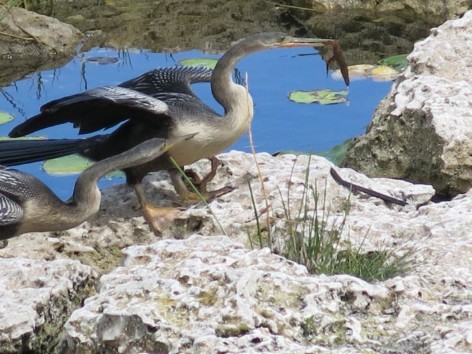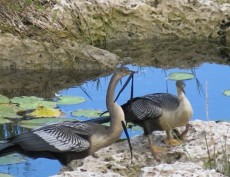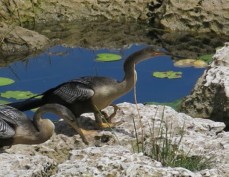William E. Davis, Jr.
While walking along Anhinga Trail in Everglades National Park, South Florida, on April 8, 2015, about 11:30 am, my attention was drawn to two Anhingas (Anhinga anhinga). The two were facing in the same direction, were close together, and both had vegetable material in their bills (Figure 1). As I watched, they tossed the vegetation into the air and caught it. Over the next 10 minutes they repeatedly did these maneuvers and on several occasions one bird passed vegetation to the other bird. Most of the vegetation involved was flaccid plant debris (Figure 2) but on at least one occasion they used a stick (Figure 3, far bird). The following day I observed another presumed subadult Anhinga—it was wet and the subtleties of the feather patterns were problematic—come out of the water with a 4-inch piece of bark, which the bird tossed and caught. This second observation on April 9 was at the Big Cyprus Bend Boardwalk of Fakahatchee Strand State Park, over 100 miles from Anhinga Trail, so undoubtedly of a third individual.
The Anhingas on Anhinga Trail were both in female plumage, but young Anhingas of both sexes have such plumage. These birds were juveniles or subadults with no fine barring on their tails, gray rather than white secondaries, and substantial brown on the neck (Sibley 2000). Anhingas do not attain definitive plumage until their third year (Frederick and Siegel-Causey 2000).
Play, including practice foraging, is widespread in birds (Fagen 1981) though rare in many families, such as herons (Davis 2001). Anhingas forage for fish and impale prey on their bill. They typically shake the impaled fish off their bill, toss it into the air, and then catch and swallow it headfirst. It seems likely that the Anhinga stick- tossing and catching is play that mimics adult foraging behavior and is involved in developing and practicing skills crucial for survival, as suggested by Kilham (1974) for woodpeckers. The tossing of sticks by Anhingas has been previously reported by Stevenson and Anderson (1994), but their observations were of young birds several weeks old and unable to fly. The birds I observed were substantially older and fledged.
The passing of vegetation from one Anhinga to another also has an analogue in adult Anhinga behavior. In courtship, males may pass twigs to the female, and the male also feeds the female on nest (Allen 1961). Pre-copulatory behavior includes mutual twig offerings. It seems possible that the play I witnessed may again be practice of adult behavior.

Fig, 1. Anhingas with vegetable material in their bills. (All photographs by the author).

Fig. 2. Anhingas passing flaccid plant debris.

Fig. 3. Anhinga tossing a stick.
References
- Allen, T. T. 1961. Notes on the Breeding Behavior of the Anhinga, Wilson Bulletin 73(2): 115–125.
- Davis, W. E. Jr. 2001. “Practice” Foraging by a Sub-adult Great Blue Heron, Florida Field Naturalist 29(3): 88–89.
- Fagen, R. 1981. Animal Play Behavior. New York: Oxford University Press.
- Frederick, P. C., and D. Siegel-Causey. 2000. Anhinga (Anhinga anhinga). In The Birds of North America, No. 522 (A. Poole and F. Gill, eds.). Philadelphia: The Birds of North America, Inc.
- Kilham, L. 1974. Play in Hairy, Downy, and Other Woodpeckers, Wilson Bulletin 86(1): 35–42.
- Sibley, D. A. 2000. National Audubon Society: The Sibley Guide to Birds. New York: Alfred A. Knopf.
- Stevenson, H. M., and B. H. Anderson. 1994. The Birdlife of Florida. Gainesville: University Press of Florida.
Ted Davis thanks John Kricher for reading an earlier draft of the manuscript.